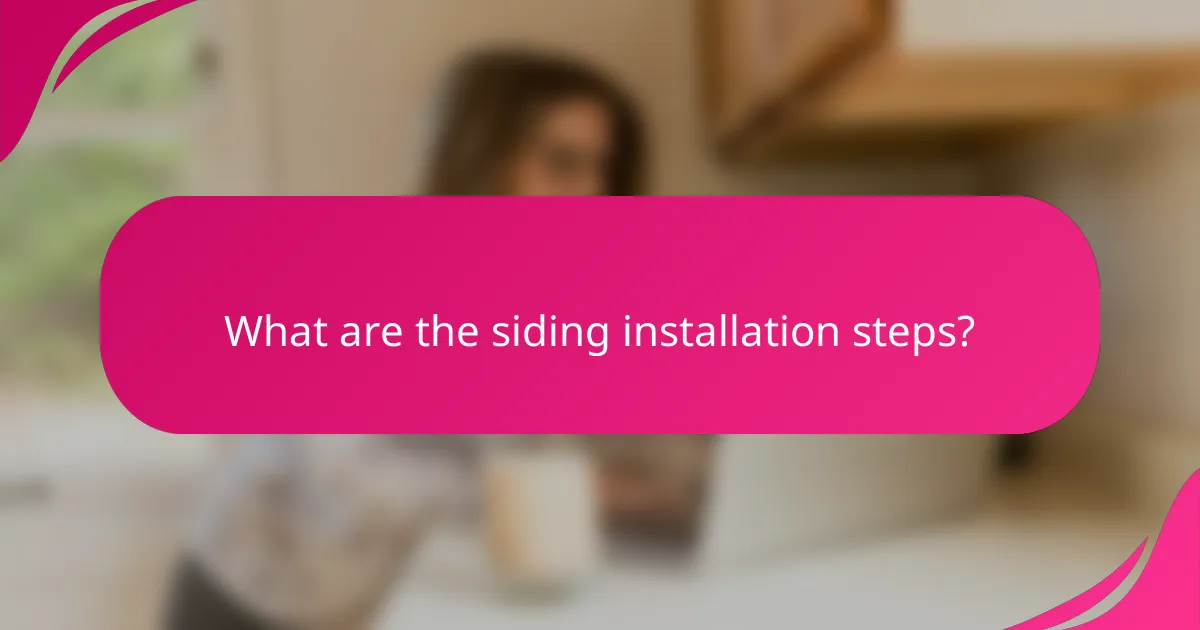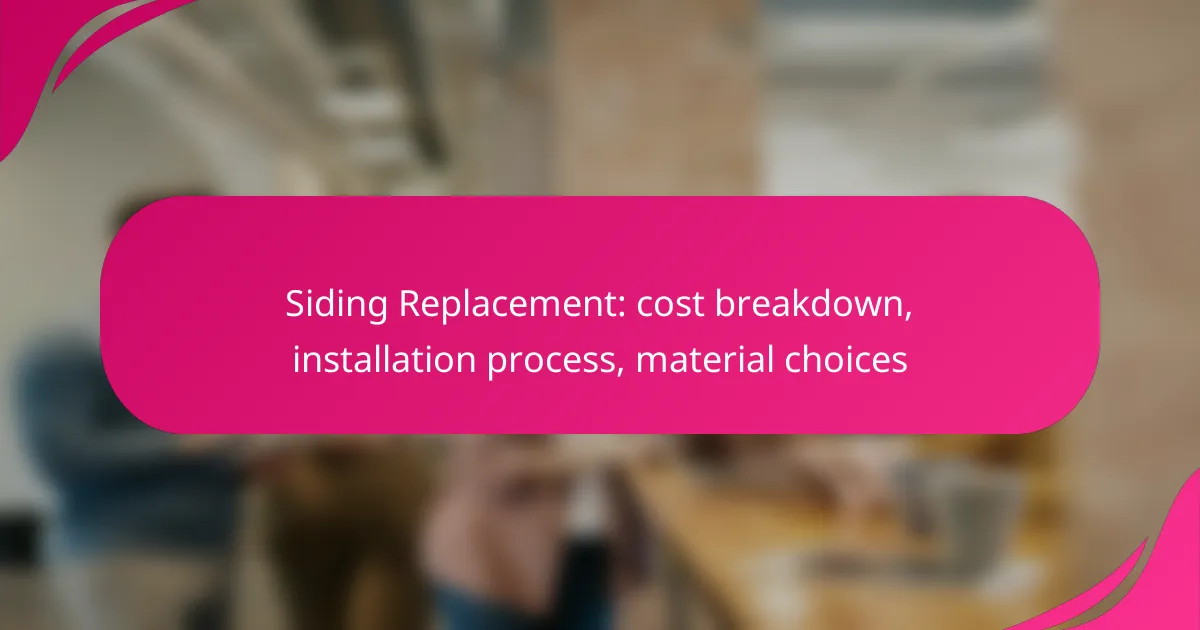Siding replacement is a significant home improvement project that typically costs between $3 and $15 per square foot, influenced by material choice and installation complexity. The installation process involves careful planning and execution to ensure both durability and visual appeal. Homeowners can choose from various materials, including vinyl, wood, and fiber cement, each offering distinct advantages based on budget, climate, and aesthetic preferences.

What is the cost of siding replacement in the United States?
The cost of siding replacement in the United States typically ranges from $3 to $15 per square foot, depending on the material and installation complexity. Homeowners should budget for both the siding material and labor when planning for this project.
Average cost per square foot
The average cost per square foot for siding replacement varies significantly based on the chosen material. Vinyl siding generally costs between $3 and $7 per square foot, while fiber cement can range from $6 to $12 per square foot. Higher-end materials like wood or stone can exceed $15 per square foot.
Installation costs can add an additional $1 to $5 per square foot, depending on the complexity of the job and local labor rates. It’s essential to obtain multiple quotes to understand the specific costs in your area.
Factors affecting total cost
Other considerations include the condition of the existing siding, which may require removal and disposal, and any necessary repairs to the underlying structure. Local labor rates and building codes can also impact the final price.
Cost comparison by material type
When comparing costs by material type, vinyl siding is often the most economical choice, offering durability and low maintenance at a reasonable price. Fiber cement provides a good balance of cost and longevity, while wood siding offers aesthetic appeal but comes with higher maintenance costs.
Stone and brick siding, while visually striking and durable, represent the higher end of the cost spectrum. Homeowners should weigh the initial investment against long-term maintenance and energy efficiency when selecting materials for their siding replacement project.

What are the siding installation steps?
Siding installation involves several key steps that ensure a successful replacement. Proper planning and execution are crucial for achieving durability and aesthetic appeal.
Initial assessment and measurement
The first step in siding installation is conducting a thorough assessment of the existing structure. This includes measuring the total area that requires new siding and checking for any underlying damage that needs repair.
During this phase, consider the type of siding you plan to install, as different materials may have unique requirements. Accurate measurements will help you estimate the amount of material needed and avoid excess costs.
Removal of old siding
Once the assessment is complete, the next step is to carefully remove the old siding. This process typically involves prying off the existing panels without damaging the underlying structure.
Be cautious of any hidden issues, such as rot or mold, that may be revealed during removal. Addressing these problems before installing new siding is essential to ensure a long-lasting finish.
Installation of new siding
The final step is the installation of the new siding. Begin by preparing the surface, which may include adding insulation or a moisture barrier for better energy efficiency and protection.
Follow the manufacturer’s guidelines for the specific siding material you are using, as installation techniques can vary. Ensure that all panels are securely fastened and properly aligned to prevent gaps that could lead to water intrusion.

What are the best siding materials available?
The best siding materials include vinyl, wood, and fiber cement, each offering unique benefits and considerations. Choosing the right siding depends on factors like budget, climate, and desired aesthetics.
Vinyl siding benefits
Vinyl siding is popular due to its affordability and low maintenance requirements. It typically costs between $2 to $7 per square foot, making it a budget-friendly option for many homeowners.
Additionally, vinyl siding is available in a wide range of colors and styles, allowing for customization without the need for painting. It is also resistant to rot and pests, which can lead to long-term savings on repairs.
Wood siding advantages
Wood siding offers a classic and natural look that many homeowners appreciate. It can range from $3 to $10 per square foot, depending on the type of wood and finish.
While wood siding can be more expensive and requires regular maintenance, such as painting or staining, it provides excellent insulation and can increase property value. Choosing treated wood can help mitigate issues with moisture and pests.
Fiber cement siding features
Fiber cement siding combines the durability of cement with the aesthetic appeal of wood. It typically costs between $5 to $12 per square foot and is known for its resistance to fire, insects, and rot.
This material can mimic the appearance of wood or stucco, providing versatility in design. Although it requires professional installation, its longevity and low maintenance needs make it a worthwhile investment for many homeowners.

How to choose the right siding for your home?
Choosing the right siding for your home involves assessing your local climate, the architectural style of your house, and your budget. Each factor plays a crucial role in ensuring durability, aesthetic appeal, and financial feasibility.
Climate considerations
Your local climate significantly influences the type of siding you should choose. For instance, homes in areas with heavy rainfall may benefit from materials like vinyl or fiber cement, which resist moisture. In contrast, homes in dry, hot climates might be better suited for stucco or wood siding that can withstand high temperatures.
Additionally, consider insulation properties. Siding with good insulation can help regulate indoor temperatures, reducing energy costs. Look for materials rated for your climate zone to ensure optimal performance.
Home style compatibility
The architectural style of your home should guide your siding choice to maintain aesthetic harmony. Traditional homes often look best with wood or brick siding, while modern designs may favor sleek materials like metal or fiber cement. Matching the siding to your home’s style enhances curb appeal and can increase property value.
Research local trends and styles to see what is commonly used in your neighborhood. This can provide inspiration and ensure your home fits in with the surrounding properties.
Budget constraints
Your budget is a critical factor when selecting siding. Costs can vary widely based on material, with options ranging from economical vinyl to high-end wood or stone. On average, homeowners might spend anywhere from $3 to $12 per square foot, depending on the material and installation complexity.
When budgeting, factor in not only the initial cost of materials but also installation expenses and long-term maintenance. Some materials may have a higher upfront cost but require less maintenance over time, making them more economical in the long run.

What are the local regulations for siding replacement?
Local regulations for siding replacement vary by municipality and often include building codes and permit requirements. It’s essential to check with local authorities to ensure compliance with these regulations before starting any siding project.
Building codes in major US cities
Building codes dictate the standards for construction and renovation, including siding replacement. In cities like New York, Los Angeles, and Chicago, these codes may specify materials, installation techniques, and energy efficiency requirements. For instance, New York City mandates that certain siding materials must meet fire safety standards, while Los Angeles may have regulations regarding the use of sustainable materials.
Homeowners should consult their city’s building department or website for specific codes that apply to their area. Understanding these regulations can help avoid costly fines and ensure the project meets safety standards.
Permit requirements
Most municipalities require a permit for siding replacement to ensure compliance with local building codes. The process typically involves submitting plans and specifications to the local building department. Permit fees can range from low tens of dollars to several hundred, depending on the project’s scope and location.
Before starting work, check if your project requires a permit. Failing to obtain one can lead to delays, fines, or even having to remove the newly installed siding. Always keep a copy of the permit on-site during the installation process to avoid complications with inspections.

What are the common siding replacement mistakes?
Common siding replacement mistakes include improper installation and choosing low-quality materials. These errors can lead to costly repairs and reduced lifespan of the siding, ultimately affecting the home’s value and energy efficiency.
Improper installation issues
Improper installation can result in various problems, such as water infiltration, poor insulation, and premature wear. For instance, failing to use the right fasteners or not allowing for proper expansion can lead to warping and buckling.
To avoid these issues, ensure that the installation follows manufacturer guidelines and local building codes. Hiring a qualified contractor with experience in siding installation can significantly reduce the risk of mistakes.
Choosing low-quality materials
Opting for low-quality siding materials can lead to frequent repairs and replacements, costing more in the long run. Cheaper options may not withstand harsh weather conditions, leading to fading, cracking, or rotting.
When selecting siding, consider materials that offer a good balance of durability and cost, such as fiber cement or high-quality vinyl. Investing in better materials can enhance your home’s curb appeal and energy efficiency, ultimately saving money over time.

What is the expected lifespan of different siding materials?
The lifespan of siding materials varies significantly, typically ranging from about 10 to 50 years depending on the type. Factors such as climate, maintenance, and installation quality also play crucial roles in determining how long siding will last.
Vinyl Siding
Vinyl siding generally lasts between 20 to 40 years. It is resistant to rot and insects, making it a popular choice for homeowners. However, extreme temperatures and direct sunlight can cause it to fade or warp over time.
Wood Siding
Wood siding can last around 20 to 30 years if properly maintained. Regular painting or staining is essential to protect it from moisture and pests. Untreated wood may deteriorate more quickly, especially in humid or wet climates.
Fiber Cement Siding
Fiber cement siding is known for its durability, with a lifespan of 30 to 50 years. It is resistant to fire, insects, and rot, making it a strong choice for various climates. However, it can be more expensive upfront compared to other materials.
Metal Siding
Metal siding, including aluminum and steel, typically lasts 40 to 70 years. It is highly durable and resistant to weather conditions, but it may be prone to dents and corrosion if not properly coated. Regular maintenance can extend its lifespan significantly.
Stucco Siding
Stucco siding can last around 50 years or more when installed correctly. It is durable and requires minimal maintenance, but it can crack in areas with extreme temperature fluctuations. Proper sealing and painting can help prevent moisture issues.
